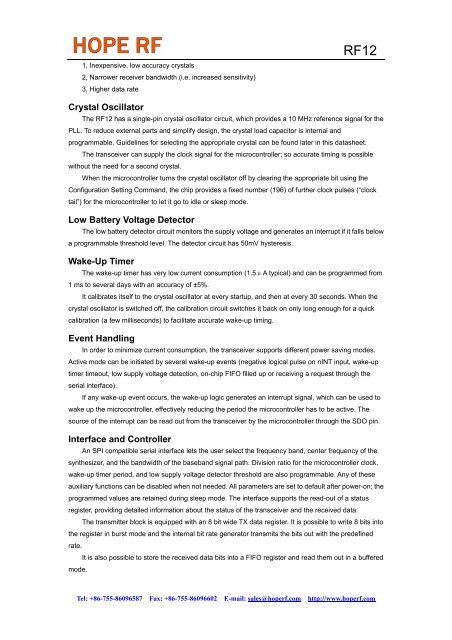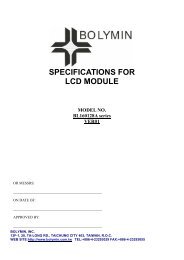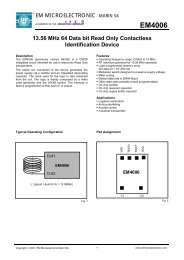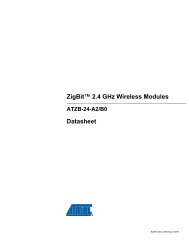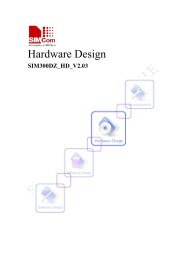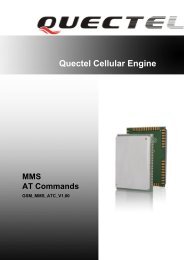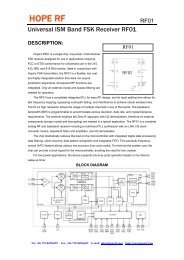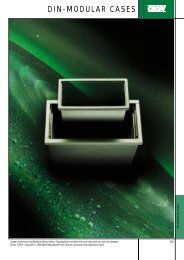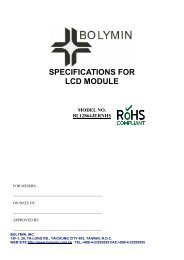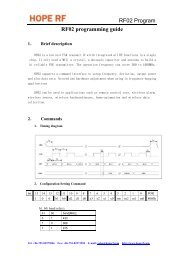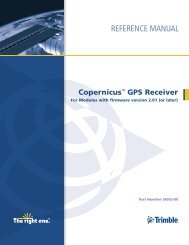RF12 Universal ISM Band FSK Transceiver
RF12 Universal ISM Band FSK Transceiver
RF12 Universal ISM Band FSK Transceiver
You also want an ePaper? Increase the reach of your titles
YUMPU automatically turns print PDFs into web optimized ePapers that Google loves.
1, Inexpensive, low accuracy crystals<br />
2, Narrower receiver bandwidth (i.e. increased sensitivity)<br />
3, Higher data rate<br />
<strong>RF12</strong><br />
Crystal Oscillator<br />
The <strong>RF12</strong> has a single-pin crystal oscillator circuit, which provides a 10 MHz reference signal for the<br />
PLL. To reduce external parts and simplify design, the crystal load capacitor is internal and<br />
programmable. Guidelines for selecting the appropriate crystal can be found later in this datasheet.<br />
The transceiver can supply the clock signal for the microcontroller; so accurate timing is possible<br />
without the need for a second crystal.<br />
When the microcontroller turns the crystal oscillator off by clearing the appropriate bit using the<br />
Configuration Setting Command, the chip provides a fixed number (196) of further clock pulses (“clock<br />
tail”) for the microcontroller to let it go to idle or sleep mode.<br />
Low Battery Voltage Detector<br />
The low battery detector circuit monitors the supply voltage and generates an interrupt if it falls below<br />
a programmable threshold level. The detector circuit has 50mV hysteresis.<br />
Wake-Up Timer<br />
The wake-up timer has very low current consumption (1.5μA typical) and can be programmed from<br />
1 ms to several days with an accuracy of ±5%.<br />
It calibrates itself to the crystal oscillator at every startup, and then at every 30 seconds. When the<br />
crystal oscillator is switched off, the calibration circuit switches it back on only long enough for a quick<br />
calibration (a few milliseconds) to facilitate accurate wake-up timing.<br />
Event Handling<br />
In order to minimize current consumption, the transceiver supports different power saving modes.<br />
Active mode can be initiated by several wake-up events (negative logical pulse on nINT input, wake-up<br />
timer timeout, low supply voltage detection, on-chip FIFO filled up or receiving a request through the<br />
serial interface).<br />
If any wake-up event occurs, the wake-up logic generates an interrupt signal, which can be used to<br />
wake up the microcontroller, effectively reducing the period the microcontroller has to be active. The<br />
source of the interrupt can be read out from the transceiver by the microcontroller through the SDO pin.<br />
Interface and Controller<br />
An SPI compatible serial interface lets the user select the frequency band, center frequency of the<br />
synthesizer, and the bandwidth of the baseband signal path. Division ratio for the microcontroller clock,<br />
wake-up timer period, and low supply voltage detector threshold are also programmable. Any of these<br />
auxiliary functions can be disabled when not needed. All parameters are set to default after power-on; the<br />
programmed values are retained during sleep mode. The interface supports the read-out of a status<br />
register, providing detailed information about the status of the transceiver and the received data.<br />
The transmitter block is equipped with an 8 bit wide TX data register. It is possible to write 8 bits into<br />
the register in burst mode and the internal bit rate generator transmits the bits out with the predefined<br />
rate.<br />
It is also possible to store the received data bits into a FIFO register and read them out in a buffered<br />
mode.<br />
Tel: +86-755-86096587 Fax: +86-755-86096602 E-mail: sales@hoperf.com http://www.hoperf.com


